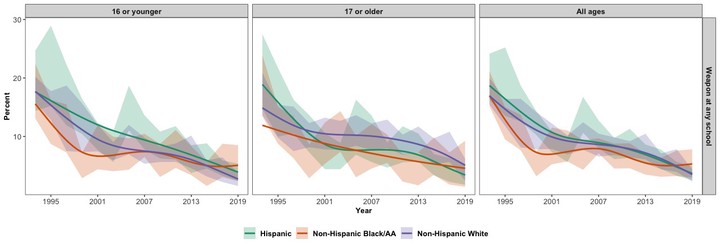
Abstract
Background: High adolescent gun-related mortality, gun-violence, pro-gun policies, white supremacy, and the long-term socioeconomic and other effects of racial oppression are intricately linked in the United States. Racist prejudice depicts male individuals of color as more prone to criminality than White males. We described long-term patterns of weapon-carrying in US schools among Non-Hispanic White, Non-Hispanic Black/African American, and Hispanic boys, hypothesizing that in contrast to racist stereotypes, boys of color did not bring weapons into schools more often than Non-Hispanic White boys in recent years. Methods: We conducted a time series analysis using 1993-2019 Youth Risk Behavior Surveillance System data comparing boys’ self-reported weapon-carrying in a nationally representative sample of US high schools by race/ethnicity and age, and by self-reported experience of safety and violence at school. Results: Weapon-carrying in schools has declined among all boys. Comparing all schools, we found no significant differences in weapon-carrying (4-5%) by race/ethnicity in 2017/2019. Boys who reported experiencing violence or feeling unsafe at school were at least twice as likely to bring a weapon into school, and such negative experiences were more common among boys of color (8-12%) than Non-Hispanic White boys (4-5%). In schools perceived as safer, NonHispanic White boys have been more likely to bring weapons into schools than Non-Hispanic Black/African American or Hispanic boys in the past 20 years. Conclusion: Our findings contradict racist prejudice with regards to weapon-carrying in schools, particularly in more favorable school environments. Making school safer may reduce weaponcarrying in schools where weapon-carrying is most common.